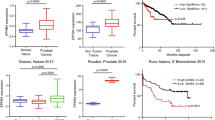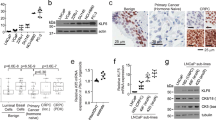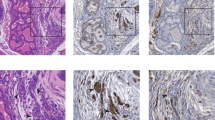Abstract
Most cancers arise from the stepwise accumulation of genetic changes. There is also evidence for defects in the machinery and checkpoints for maintenance of normal diploid chromosome complements, resulting in genetic instability that helps fuel the accumulation of mutations that contribute to the development of cancer. The proto-oncogene protein kinase B (PKB/Akt), and its regulators including phosphatidylinositol 3′ kinase and PTEN, has been shown to play critical roles in the regulation of multiple cellular functions such as transcription, cell survival, cell cycle progression, angiogenesis and cell motility – all of which are important to the malignant process. Here, we report the use of a membrane targeted PKBβ, the activation of which is under the control of a 4-hydroxy-Tamoxifen-responsive estrogen-receptor (ER) ligand binding domain. Induction of PKBβ-ER activity in human kidney epithelial cells (HEK293) resulted in changes in cellular growth, size, and in the appearance of aneuploid cells. Over time, in a PKBβ-dependent manner, cells also underwent extensive multinucleation caused due to a combination of both endomitosis and cell fusion. These findings suggest that chronic activation of PKBβ may contribute to genetic instability and autophagy, properties commonly found in tumor cells.
This is a preview of subscription content, access via your institution
Access options
Subscribe to this journal
Receive 50 print issues and online access
$259.00 per year
only $5.18 per issue
Buy this article
- Purchase on Springer Link
- Instant access to full article PDF
Prices may be subject to local taxes which are calculated during checkout









Similar content being viewed by others
References
Anand S, Penrhyn-Lowe S and Venkitaraman AR . (2003). Cancer Cell, 3, 51–62.
Arboleda MJ, Lyons JF, Kabbinavar FF, Bray MR, Snow BE, Ayala R, Danino M, Karlan BY and Slamon DJ . (2003). Cancer Res., 63, 196–206.
Bacus SS, Altomare DA, Lyass L, Chin DM, Farrell MP, Gurova K, Gudkov A and Testa JR . (2002). Oncogene, 21, 3532–3540.
Bellacosa A, Testa JR, Staal SP and Tsichlis PN . (1991). Science, 254, 274–277.
Bischoff JR, Anderson L, Zhu Y, Mossie K, Ng L, Souza B, Schryver B, Flanagan P, Clairvoyant F, Ginther C, Chan CS, Novotny M, Slamon DJ and Plowman GD . (1998). EMBO J., 17, 3052–3065.
Bischoff JR and Plowman GD . (1999). Trends Cell Biol., 9, 454–459.
Botelho RJ, Scott CC and Grinstein S . (2004). Curr. Top. Microbiol. Immunol., 282, 1–30.
Brazil DP, Yang ZZ and Hemmings BA . (2004). Trends Biochem. Sci., 29, 233–242.
Brunet A, Bonni A, Zigmond MJ, Lin MZ, Juo P, Hu LS, Anderson MJ, Arden KC, Blenis J and Greenberg ME . (1999). Cell, 96, 857–868.
Cantley LC . (2002). Science, 296, 1655–1657.
Cheng JQ, Godwin AK, Bellacosa A, Taguchi T, Franke TF, Hamilton TC, Tsichlis PN and Testa JR . (1992). Proc. Natl. Acad. Sci. USA, 89, 9267–9271.
Cheng JQ, Ruggeri B, Klein WM, Sonoda G, Altomare DA, Watson DK and Testa JR . (1996). Proc. Natl. Acad. Sci. USA, 93, 3636–3641.
Chung CY, Potikyan G and Firtel RA . (2001). Mol. Cell, 7, 937–947.
Cross DA, Alessi DR, Cohen P, Andjelkovich M and Hemmings BA . (1995). Nature, 378, 785–789.
Datta SR, Dudek H, Tao X, Masters S, Fu H, Gotoh Y and Greenberg ME . (1997). Cell, 91, 231–241.
del Peso L, Gonzalez-Garcia M, Page C, Herrera R and Nunez G . (1997). Science, 278, 687–689.
Ellson CD, Anderson KE, Morgan G, Chilvers ER, Lipp P, Stephens LR and Hawkins PT . (2001). Curr. Biol., 11, 1631–1635.
Funakoshi E, Hori T, Haraguchi T, Hiraoka Y, Kudoh J, Shimizu N and Ito F . (2003). BMC Cell Biol., 4, 12.
Funamoto S, Milan K, Meili R and Firtel RA . (2001). J. Cell. Biol., 153, 795–810.
Goepfert TM and Brinkley BR . (2000). Curr. Top Dev. Biol., 49, 331–342.
Hanahan D and Weinberg RA . (2000). Cell, 100, 57–70.
Hannak E, Kirkham M, Hyman AA and Oegema K . (2001). J. Cell Biol., 155, 1109–1116.
Hutchinson JN, Jin J, Cardiff RD, Woodgett JR and Muller WJ . (2004). Cancer Res., 64, 3171–3178.
Inoki K, Li Y, Zhu T, Wu J and Guan KL . (2002). Nat. Cell Biol., 4, 648–657.
Jin J, Anthopoulos N, Wetsch B, Binari RC, Isaac DD, Andrew DJ, Woodgett JR and Manoukian AS . (2001). Dev. Cell., 1, 817–827.
Katayama H, Ota T, Jisaki F, Ueda Y, Tanaka T, Odashima S, Suzuki F, Terada Y and Tatsuka M . (1999). J. Natl. Cancer Inst., 91, 1160–1162.
Kenerson HL, Aicher LD, True LD and Yeung RS . (2002). Cancer Res., 62, 5645–5650.
Kohn AD, Barthel A, Kovacina KS, Boge A, Wallach B, Summers SA, Birnbaum MJ, Scott PH, Lawrence Jr JC and Roth RA . (1998). J. Biol. Chem., 273, 11937–11943.
Littlewood TD, Hancock DC, Danielian PS, Parker MG and Evan GI . (1995). Nucleic. Acids Res., 23, 1686–1690.
Luo J, Manning BD and Cantley LC . (2003). Cancer Cell, 4, 257–262.
Meraldi P, Honda R and Nigg EA . (2002). EMBO J., 21, 483–492.
Mirza AM, Kohn AD, Roth RA and McMahon M . (2000). Cell Growth Differ., 11, 279–292.
Miyoshi Y, Iwao K, Egawa C and Noguchi S . (2001). Int. J. Cancer, 92, 370–373.
Mora A, Komander D, van Aalten DM and Alessi DR . (2004). Semin. Cell Dev. Biol., 15, 161–170.
Otto SP and Whitton J . (2000). Annu. Rev. Genet., 34, 401–437.
Razzini G, Berrie CP, Vignati S, Broggini M, Mascetta G, Brancaccio A and Falasca M . (2000). FASEB J., 14, 1179–1187.
Rupper A, Lee K, Knecht D and Cardelli J . (2001a). Mol. Cell. Biol., 12, 2813–2824.
Rupper AC, Rodriguez-Paris JM, Grove BD and Cardelli JA . (2001b). J. Cell Sci., 114, 1283–1295.
Russell DG . (2001). Nat. Rev. Mol. Cell. Biol., 2, 569–577.
Sakakura C, Hagiwara A, Yasuoka R, Fujita Y, Nakanishi M, Masuda K, Shimomura K, Nakamura Y, Inazawa J, Abe T and Yamagishi H . (2001). Br. J. Cancer, 84, 824–831.
Scheid MP, Marignani PA and Woodgett JR . (2002). Mol. Cell. Biol., 22, 6247–6260.
Scheid MP and Woodgett JR . (2001). Nat. Rev. Mol. Cell. Biol., 2, 760–768.
Sen S, Zhou H and White RA . (1997). Oncogene, 14, 2195–2200.
Stephens L, Ellson C and Hawkins P . (2002). Curr. Opin. Cell Biol., 14, 203–213.
Storchova Z and Pellman D . (2004). Nat. Rev. Mol. Cell. Biol., 5, 45–54.
Sulis ML and Parsons R . (2003). Trends Cell Biol., 13, 478–483.
Tee AR, Anjum R and Blenis J . (2003). J. Biol. Chem., 278, 37288–37296.
Vivanco I and Sawyers CL . (2002). Nat. Rev. Cancer, 2, 489–501.
Woods YL, Rena G, Morrice N, Barthel A, Becker W, Guo S, Unterman TG and Cohen P . (2001). Biochem. J., 355, 597–607.
Zhou H, Kuang J, Zhong L, Kuo WL, Gray JW, Sahin A, Brinkley BR and Sen S . (1998). Nat. Genet., 20, 189–193.
Acknowledgements
This work was supported by a grant from the National Cancer Institute of Canada/Canadian Cancer Society. We thank Roberta Siu, Mike Parsons, Mike Scheid, Battista Calvieri and James Jonkman for their valuable advice and assistance.
Author information
Authors and Affiliations
Corresponding author
Additional information
Supplementary Information accompanies the paper on Oncogene website (http://www.nature.com/onc)
Rights and permissions
About this article
Cite this article
Jin, J., Woodgett, J. Chronic activation of protein kinase Bβ/Akt2 leads to multinucleation and cell fusion in human epithelial kidney cells: events associated with tumorigenesis. Oncogene 24, 5459–5470 (2005). https://doi.org/10.1038/sj.onc.1208704
Received:
Revised:
Accepted:
Published:
Issue Date:
DOI: https://doi.org/10.1038/sj.onc.1208704
Keywords
This article is cited by
-
Genomic instability in mutant p53 cancer cells upon entotic engulfment
Nature Communications (2018)
-
Cell fusion in tumor progression: the isolation of cell fusion products by physical methods
Cancer Cell International (2011)
-
Fusion of tumour cells with bone marrow-derived cells: a unifying explanation for metastasis
Nature Reviews Cancer (2008)
-
The cell biology of cell-in-cell structures
Nature Reviews Molecular Cell Biology (2008)
-
Suppression of PTEN function increases breast cancer chemotherapeutic drug resistance while conferring sensitivity to mTOR inhibitors
Oncogene (2008)



